Are you fascinated by the unique architecture and cultural traditions of Vietnam? SIXT.VN guides you through the enchanting world of traditional Nung and Tay houses, also known as stilt houses, offering insights into their design, purpose, and the cultural significance they hold. Discover how these elevated homes are not just dwellings but reflections of a rich heritage, and how SIXT.VN can help you explore these cultural treasures firsthand. Journey through Vietnamese heritage, ethnic minority culture, and local customs with ease and convenience.
1. What Defines Traditional Nung and Tay Stilt Houses?
Traditional Nung and Tay houses, often referred to as stilt houses, are elevated structures built on pillars. These houses are primarily constructed from natural materials like wood, bamboo, and palm leaves, showcasing a unique architectural style adapted to the environment and cultural practices of the Nung and Tay ethnic groups in Vietnam.
1.1. Key Features of Nung and Tay Stilt Houses
These stilt houses are characterized by several distinctive features:
- Elevated Structure: The house is raised off the ground on stilts, typically made of wood. This design protects against flooding, pests, and wild animals.
- Natural Materials: Construction primarily uses wood, bamboo, and palm leaves, making the houses environmentally friendly and well-suited to the local climate.
- Large Roof: A steep, oversized roof, often thatched with palm leaves, provides shade and protection from heavy rains.
- Open Design: The living space is generally open, promoting ventilation and communal living.
- Wooden Staircase: Access to the house is via a wooden staircase, which often has an odd number of steps for good luck.
- Multiple Sections: The interior is divided into sections for various purposes, including living, sleeping, cooking, and storage.
- Minimal Furniture: Traditional houses often feature minimal furniture, with mats used for sleeping and low tables for dining.
1.2. Cultural Significance of Stilt Houses
Stilt houses are more than just dwellings; they are symbols of cultural identity and community. They reflect the traditions, beliefs, and way of life of the Nung and Tay people.
- Community and Family: The design of the house encourages communal living, strengthening family bonds and community ties.
- Respect for Nature: The use of natural materials demonstrates a deep respect for the environment and a sustainable way of life.
- Protection and Security: The elevated structure provides protection from natural threats and offers a sense of security.
- Spiritual Connection: Certain areas of the house are often dedicated to ancestral worship, reflecting the spiritual beliefs of the community.
- Social Status: The size and design of the house can indicate the social status and wealth of the family within the community.
These traditional homes embody the harmony between people and their environment, reflecting a sustainable and culturally rich way of life. Experiencing these houses offers insight into the unique heritage of the Nung and Tay ethnic groups.
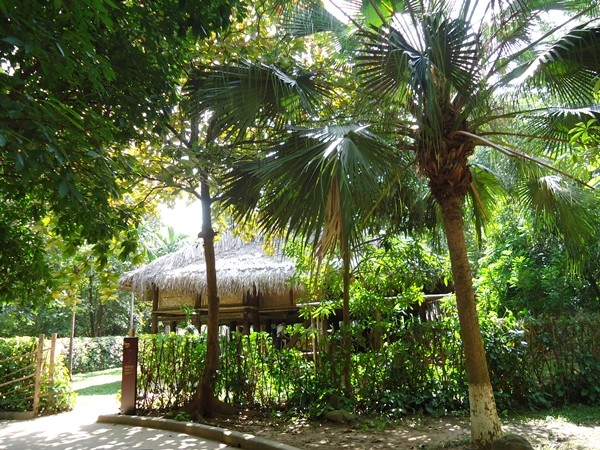 Traditional Tay stilt house at the Vietnam Museum of Ethnology, showcasing the unique architectural style and cultural heritage of the Tay people.
Traditional Tay stilt house at the Vietnam Museum of Ethnology, showcasing the unique architectural style and cultural heritage of the Tay people.
2. Where Are These Traditional Houses Typically Located?
Traditional Nung and Tay houses are typically located in the mountainous regions of Northern Vietnam. These areas provide the natural resources necessary for building the houses and offer a landscape that suits their elevated structure.
2.1. Geographical Distribution
- Northern Vietnam: Predominantly found in provinces such as Lao Cai, Yen Bai, Cao Bang, and Lang Son.
- Mountainous Regions: Located in valleys and hillsides, near water sources like rivers and streams.
- Proximity to Nature: Often surrounded by rice paddies, forests, and bamboo groves, integrating the homes into the natural landscape.
2.2. Environmental Factors
The location of these houses is influenced by several environmental factors:
- Water Sources: Proximity to water sources ensures a reliable supply for daily needs such as drinking, cooking, and agriculture.
- Natural Resources: Access to wood, bamboo, and palm leaves is essential for constructing and maintaining the houses.
- Climate: The elevated structure helps to mitigate the effects of the humid, subtropical climate, providing ventilation and protection from flooding.
- Topography: The mountainous terrain necessitates the stilt design, which provides a stable foundation on uneven ground.
2.3. Cultural and Social Considerations
In addition to environmental factors, cultural and social considerations also play a role in the location of these houses:
- Community Clustering: Houses are often clustered together to form villages, fostering a sense of community and mutual support.
- Agricultural Lands: Proximity to rice paddies and other agricultural lands ensures easy access to farming areas.
- Ancestral Lands: The location of the houses is often tied to ancestral lands, reflecting a connection to the past and a sense of belonging.
- Accessibility: While remote, the villages are typically located along established paths and trails, facilitating trade and communication with other communities.
The strategic placement of these houses reflects a deep understanding of the environment and a commitment to preserving cultural traditions. Exploring these regions offers a unique opportunity to witness the harmonious relationship between the Nung and Tay people and their natural surroundings.
3. What Materials Are Used to Build These Houses?
Traditional Nung and Tay stilt houses are primarily constructed from natural, locally sourced materials. These materials are chosen for their durability, availability, and suitability to the local climate.
3.1. Primary Building Materials
- Wood: The main structural component, used for stilts, frames, beams, and flooring. Hardwoods like ironwood are preferred for their strength and resistance to decay.
- Bamboo: Used for walls, partitions, flooring, and roofing. Bamboo is lightweight, flexible, and readily available.
- Palm Leaves: Primarily used for thatching the roof, providing excellent insulation and waterproofing. Different types of palm leaves are used based on availability and local tradition.
- Clay and Mud: Sometimes used for plastering walls or creating a foundation base, offering additional insulation and stability.
3.2. Construction Techniques
The construction of these houses involves traditional techniques passed down through generations:
- Handcrafted: Most components are handcrafted using simple tools like axes, saws, and knives.
- Interlocking Joints: Wooden members are often joined using interlocking joints, eliminating the need for nails or screws.
- Weaving: Bamboo is woven into panels for walls and partitions, providing ventilation and flexibility.
- Thatching: Palm leaves are carefully layered and tied to the roof frame, creating a waterproof and insulating barrier.
- Community Involvement: Building a house is often a community effort, with neighbors and relatives contributing labor and materials.
3.3. Sustainability
The use of natural materials and traditional construction techniques makes these houses sustainable and environmentally friendly:
- Renewable Resources: Wood, bamboo, and palm leaves are renewable resources that can be sustainably harvested.
- Low Environmental Impact: The construction process has a minimal impact on the environment, with no heavy machinery or industrial processes involved.
- Biodegradable: At the end of their lifespan, the materials can decompose naturally, returning to the environment.
- Energy Efficiency: The natural materials provide excellent insulation, reducing the need for artificial heating or cooling.
The choice of materials and construction methods reflects a deep understanding of the local environment and a commitment to sustainable living. Visiting these houses provides insight into the ingenuity and resourcefulness of the Nung and Tay people.
 Close-up of a palm leaf roof on a traditional Tay house, showcasing the intricate thatching technique and the use of natural materials.
Close-up of a palm leaf roof on a traditional Tay house, showcasing the intricate thatching technique and the use of natural materials.
4. What is the Purpose of the Stilts?
The stilts in traditional Nung and Tay houses serve multiple crucial purposes, making them an essential feature of this architectural style.
4.1. Protection from Flooding
- Elevated Living Space: The primary purpose of the stilts is to raise the living space above ground level, protecting it from seasonal flooding, which is common in the low-lying areas where these houses are often built.
- Preservation of Belongings: By elevating the house, the stilts help to keep belongings and food supplies safe from water damage.
4.2. Pest and Animal Control
- Reduced Pest Infestation: Raising the house makes it more difficult for pests like insects, rodents, and snakes to enter the living area.
- Protection from Wild Animals: The stilts provide a barrier against larger wild animals that may roam the surrounding areas.
4.3. Ventilation and Cooling
- Improved Air Circulation: The elevated structure allows for better air circulation beneath the house, helping to keep the living space cool and comfortable in the hot and humid climate.
- Natural Ventilation: Air can flow freely around the house, reducing the risk of mold and mildew.
4.4. Storage and Workspace
- Under-House Storage: The space beneath the house can be used for storage of tools, equipment, and firewood.
- Workspace: In some cases, the area under the house serves as a shaded workspace for crafts, repairs, or other activities.
4.5. Foundation Stability
- Adaptation to Terrain: Stilts allow the houses to be built on uneven or sloping terrain, providing a stable foundation where traditional foundations might be impractical.
- Reduced Soil Contact: By minimizing contact with the ground, the stilts help to prevent moisture from seeping into the house, prolonging its lifespan.
4.6. Cultural Significance
- Symbolic Elevation: In some communities, the act of elevating the house has symbolic significance, representing a separation from the earth and a connection to the spiritual realm.
- Social Status: The height and design of the stilts can sometimes reflect the social status or wealth of the family.
The stilts are not just structural supports but integral components that contribute to the functionality, sustainability, and cultural significance of traditional Nung and Tay houses.
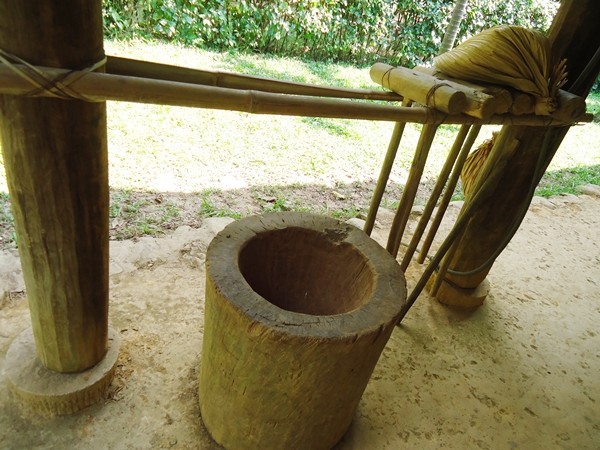 Stilts supporting a traditional Tay house, illustrating how they elevate the structure to protect it from flooding and pests.
Stilts supporting a traditional Tay house, illustrating how they elevate the structure to protect it from flooding and pests.
5. How is the Interior Space Organized in a Traditional Stilt House?
The interior space of a traditional Nung or Tay stilt house is thoughtfully organized to accommodate various activities and reflect the cultural practices of the inhabitants.
5.1. Open Living Area
- Communal Space: The main living area is typically an open space used for dining, socializing, and other communal activities.
- Minimal Furniture: Furniture is often minimal, with mats and low tables used for sitting and eating on the floor.
5.2. Sleeping Area
- Designated Sleeping Zones: Sleeping areas are usually designated zones within the open living space, with mats or platforms used for beds.
- Family Arrangement: Family members often sleep together in the same area, fostering a sense of closeness and security.
- Elevated Platforms: Older members of the family may have elevated sleeping platforms to show respect.
5.3. Kitchen and Cooking Area
- Fireplace: The kitchen area typically centers around a fireplace, which is used for cooking and heating.
- Storage: Shelves and containers are used to store cooking utensils, food supplies, and other kitchen items.
- Central Heart: The fireplace is often considered the heart of the home, where family members gather to share stories and meals.
5.4. Pantry and Storage
- Food Storage: Pantries or storage areas are used to keep rice, grains, and other food supplies safe from pests and moisture.
- Household Items: These areas also store household items, tools, and equipment.
5.5. Ancestral Altar
- Dedicated Space: Many stilt houses have a dedicated space for an ancestral altar, where family members pay respects to their ancestors.
- Spiritual Significance: The altar is often located in a prominent area of the house, reflecting the importance of ancestor worship in the culture.
5.6. “Water Terrace”
- Bamboo or Palm Construction: Located at the top of the staircase, the “water terrace” is made of bamboo or palm trees.
- Multi-functional Space: Used for keeping water, washing items, bathing, and other household chores.
5.7. Drying Place
- Adjacent to Terrace: Situated next to the terrace, this area is used for drying corn, manioc roots, and other items.
5.8. Newlywed’s Room
- Special Room: A dedicated space for the new bride when a son in the family gets married.
- Traditions: On the wedding day, the bride sleeps with her bridesmaid, and only from the second day can the couple share the bed.
5.9. Windows
- Ample Ventilation: Many windows are opened to bring wind and light into the house.
The interior layout is designed to maximize the use of space, promote communal living, and reflect the cultural values of the Nung and Tay people.
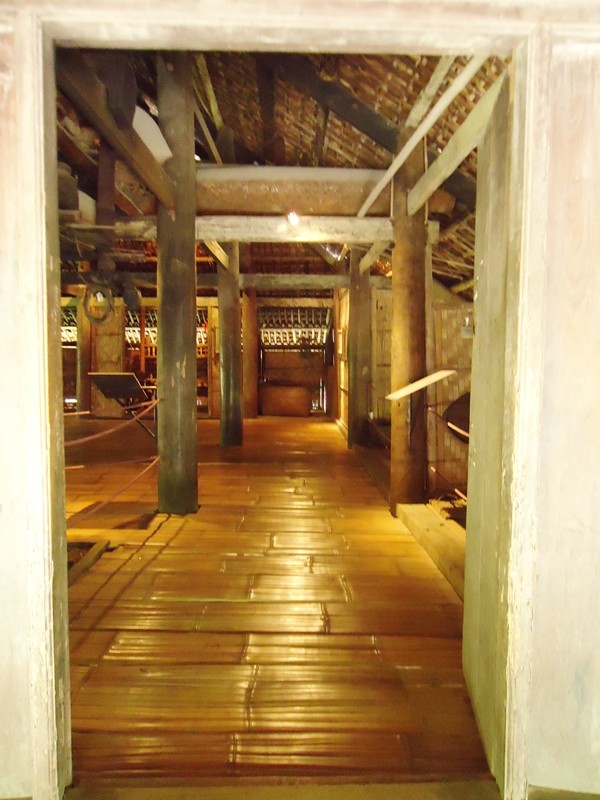 Interior of a traditional Tay house, showing the open living space with minimal furniture and the bamboo floor.
Interior of a traditional Tay house, showing the open living space with minimal furniture and the bamboo floor.
6. What Customs and Traditions Are Associated with These Houses?
Traditional Nung and Tay stilt houses are deeply intertwined with various customs and traditions that reflect the cultural values and beliefs of these ethnic groups.
6.1. Building the House
- Choosing the Location: The location of the house is carefully chosen based on factors such as proximity to water sources, soil quality, and the advice of a local shaman.
- Selecting Materials: The selection of building materials is often guided by tradition, with certain types of wood and bamboo preferred for their durability and symbolic significance.
- Community Involvement: Building a house is a communal effort, with neighbors and relatives helping with construction.
6.2. Moving into the House
- Housewarming Ceremony: A housewarming ceremony is held to bless the new house and bring good luck to the family.
- Ancestral Offerings: Offerings are made to the ancestors to seek their protection and guidance.
- Symbolic Items: Symbolic items, such as rice, salt, and fire, are brought into the house to ensure prosperity and well-being.
6.3. Daily Life
- Respect for Elders: Elders are given the most respected places in the house, and their advice is highly valued.
- Communal Meals: Meals are often eaten together as a family, fostering a sense of togetherness and sharing.
- Storytelling: Storytelling is a common pastime, with elders sharing stories and legends that have been passed down through generations.
6.4. Spiritual Beliefs
- Ancestor Worship: Ancestor worship is an integral part of the culture, with families paying respects to their ancestors through offerings and rituals.
- Spirits of the House: It is believed that spirits reside in the house, and offerings are made to appease them and seek their protection.
- Superstitions: Various superstitions are associated with the house, such as avoiding certain activities on certain days to prevent bad luck.
6.5. Etiquette
- Cleanliness: Cleanliness is highly valued, and the house is kept tidy and well-maintained.
- Respect for Guests: Guests are treated with utmost respect and hospitality.
- Removing Shoes: Shoes are typically removed before entering the house as a sign of respect.
- Washing Feet: Before entering the house, washing feet using water from a bamboo tube next to the staircase is a common practice.
- Staircase Etiquette: When greeting important guests, the house owner usually comes down to invite them and walks behind them up the staircase to protect and guide them.
6.6. Newlywed Traditions
- Bride’s Room: A special room is designated for the new bride, where she sleeps with her bridesmaid on the wedding day.
- Restricted Access: Except for her husband, no other man is allowed to enter the bride’s room.
6.7. Prohibitions
- Altar Respect: Guests or women who have just given birth are not allowed to sit or sleep in front of the ancestor altar.
- Yelling: Tay people avoid yelling at others in the house, especially in the kitchen, as it is believed to insult ancestors and house spirits.
These customs and traditions play a vital role in preserving the cultural identity of the Nung and Tay people and ensuring the continuity of their way of life.
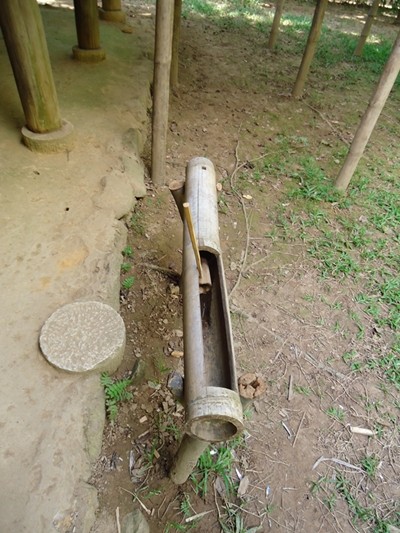 Bamboo tube with water, symbolizing the custom of washing feet before entering a traditional Tay house.
Bamboo tube with water, symbolizing the custom of washing feet before entering a traditional Tay house.
7. How Can Visitors Experience These Traditional Houses?
Visitors interested in experiencing traditional Nung and Tay stilt houses have several options, ranging from cultural tours to homestays.
7.1. Cultural Tours
- Organized Tours: Many tour operators offer cultural tours that include visits to Nung and Tay villages, providing an opportunity to see the traditional houses firsthand.
- Guided Experiences: These tours often include guided tours of the villages, with explanations of the history, culture, and customs of the local people.
- Interaction with Locals: Some tours also offer opportunities to interact with local people, participate in traditional activities, and learn about their way of life.
7.2. Homestays
- Authentic Experience: Staying in a homestay is a great way to experience the traditional houses and culture up close.
- Family Stay: Homestays involve staying with a local family in their home, sharing meals, and participating in daily activities.
- Cultural Immersion: This provides a unique opportunity for cultural immersion and a deeper understanding of the local way of life.
7.3. Eco-Lodges
- Sustainable Tourism: Eco-lodges are accommodations that are designed to minimize their impact on the environment and support local communities.
- Traditional Design: Some eco-lodges are built in the style of traditional stilt houses, offering a comfortable and sustainable way to experience the local culture.
- Responsible Travel: Staying in an eco-lodge supports responsible tourism and helps to preserve the local environment and culture.
7.4. Museums
- Vietnam Museum of Ethnology: Located in Hanoi, this museum features replicas of traditional houses from various ethnic groups, including the Nung and Tay.
- Educational Experience: Visiting the museum provides an educational experience and a good introduction to the traditional architecture and culture of these groups.
7.5. Respectful Travel Tips
- Cultural Sensitivity: When visiting Nung and Tay villages, it is important to be respectful of local customs and traditions.
- Dress Appropriately: Dress modestly and avoid wearing revealing clothing.
- Ask Permission: Always ask permission before taking photos of people or entering their homes.
- Support Local Economy: Buy local products and support local businesses to help sustain the community.
7.6. SIXT.VN Services
- Transportation: SIXT.VN offers reliable transportation services to and from the villages, making it easy to reach these remote areas.
- Accommodation: SIXT.VN can help you find suitable accommodation, whether it’s a homestay or an eco-lodge.
- Tours: SIXT.VN can arrange guided tours of the villages, providing you with an informative and enriching experience.
- Travel Support: SIXT.VN provides comprehensive travel support, ensuring a smooth and hassle-free trip.
By choosing the right option and following these tips, visitors can have a memorable and enriching experience while respecting the culture and traditions of the Nung and Tay people.
 The wooden staircase of a traditional Tay house, with an odd number of steps, leading to the elevated living space.
The wooden staircase of a traditional Tay house, with an odd number of steps, leading to the elevated living space.
8. What Role Do These Houses Play in Modern Society?
While traditional Nung and Tay stilt houses remain an important part of the cultural heritage, their role in modern society is evolving.
8.1. Preservation of Cultural Identity
- Symbol of Heritage: The houses serve as a symbol of cultural identity for the Nung and Tay people, reminding them of their traditions and history.
- Cultural Tourism: The houses attract tourists interested in experiencing the local culture, providing a source of income for the communities.
8.2. Adaptation to Modern Living
- Modern Amenities: Some families have adapted their traditional houses to include modern amenities such as electricity, running water, and modern appliances.
- Building Materials: While maintaining the traditional design, some families are using modern building materials to improve the durability and comfort of their homes.
8.3. Challenges
- Economic Pressures: Economic pressures can lead some families to abandon their traditional houses in favor of more modern housing options.
- Cultural Loss: The younger generation may be less interested in maintaining the traditional way of life, leading to a loss of cultural knowledge and skills.
- Environmental Threats: Deforestation and other environmental threats can make it difficult to obtain the natural materials needed to build and maintain the houses.
8.4. Sustainable Development
- Eco-Tourism: Promoting eco-tourism can provide economic incentives for preserving the traditional houses and culture.
- Community-Based Tourism: Encouraging community-based tourism can empower local communities to manage and benefit from tourism activities.
- Cultural Education: Educating the younger generation about the value of their cultural heritage can help to ensure its survival.
8.5. Government Support
- Preservation Programs: Government programs can provide financial and technical support for preserving traditional houses and cultural sites.
- Cultural Promotion: Promoting the Nung and Tay culture through festivals, museums, and educational programs can raise awareness and appreciation.
8.6. SIXT.VN’s Role
- Sustainable Tourism: SIXT.VN promotes sustainable tourism practices that respect and support local cultures and environments.
- Cultural Experiences: SIXT.VN offers tours and experiences that provide visitors with an authentic and enriching understanding of the Nung and Tay culture.
- Local Partnerships: SIXT.VN partners with local communities to support their economic development and cultural preservation efforts.
By balancing the preservation of cultural heritage with the need for modern development, it is possible to ensure that traditional Nung and Tay stilt houses continue to play a meaningful role in modern society.
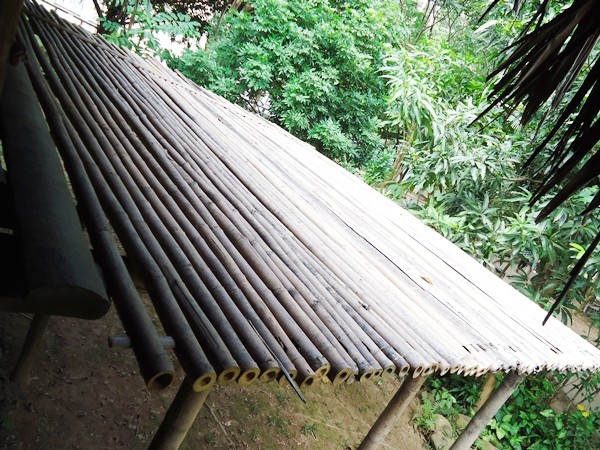 Drying place near a traditional Tay house, showcasing the use of the area for practical purposes.
Drying place near a traditional Tay house, showcasing the use of the area for practical purposes.
9. What Are Some Common Misconceptions About Stilt Houses?
There are several misconceptions about stilt houses, often stemming from a lack of understanding of their purpose and cultural significance.
9.1. They Are Only for Poor People
- Misconception: Stilt houses are often seen as a sign of poverty, suggesting that people who live in them cannot afford better housing.
- Reality: Stilt houses are a traditional architectural style that is well-suited to the local environment and culture. They are not necessarily an indication of poverty, and many people choose to live in them out of cultural preference.
9.2. They Are Uncomfortable and Primitive
- Misconception: Stilt houses are seen as uncomfortable and primitive, lacking the amenities and comforts of modern housing.
- Reality: While traditional stilt houses may lack some modern amenities, they are designed to be comfortable and functional. The elevated structure provides ventilation and protection from pests, and the natural materials provide insulation.
9.3. They Are Unsafe
- Misconception: Stilt houses are seen as unsafe, prone to collapse or vulnerable to storms.
- Reality: When properly built and maintained, stilt houses are sturdy and safe. The elevated structure can protect them from flooding, and the natural materials are flexible and resilient.
9.4. They Are All the Same
- Misconception: All stilt houses are the same, with no variation in design or style.
- Reality: Stilt houses vary in design and style depending on the ethnic group, local traditions, and available materials. Each house is unique and reflects the culture and preferences of its inhabitants.
9.5. They Are Only Found in Rural Areas
- Misconception: Stilt houses are only found in rural areas, far from modern cities and towns.
- Reality: While stilt houses are more common in rural areas, they can also be found in some urban areas, particularly in regions where they are a traditional architectural style.
9.6. They Are Easy to Build
- Misconception: Stilt houses are easy to build, requiring little skill or effort.
- Reality: Building a stilt house requires a great deal of skill and effort. The construction process involves traditional techniques that have been passed down through generations.
9.7. They Are Not Environmentally Friendly
- Misconception: Stilt houses are not environmentally friendly because they require the use of wood and other natural resources.
- Reality: Traditional stilt houses are actually very environmentally friendly. They are built from renewable resources, and the construction process has a minimal impact on the environment.
9.8. SIXT.VN’s Commitment to Accuracy
- Education: SIXT.VN is committed to providing accurate information about stilt houses and the cultures that build them.
- Respect: SIXT.VN promotes respectful and responsible tourism that supports local communities and preserves cultural heritage.
- Authenticity: SIXT.VN offers experiences that provide visitors with an authentic and enriching understanding of stilt houses and the people who live in them.
By addressing these misconceptions and promoting accurate information, SIXT.VN helps to foster a greater appreciation for the unique architecture and cultural significance of stilt houses.
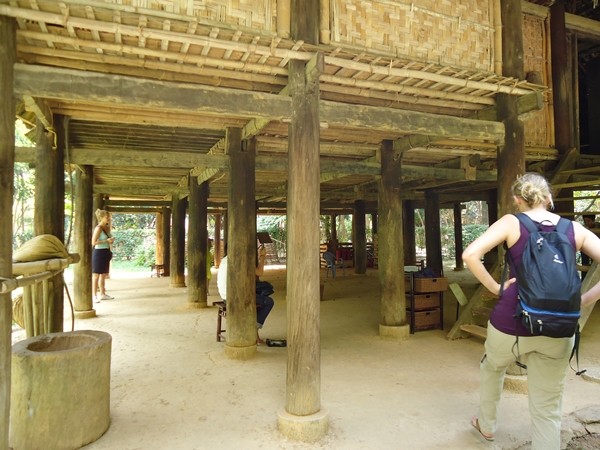 Underneath a traditional Tay house, used for storing farm furniture like wooden mortars.
Underneath a traditional Tay house, used for storing farm furniture like wooden mortars.
10. What Travel Tips Should I Know Before Visiting?
Planning a trip to visit traditional Nung and Tay stilt houses requires some preparation to ensure a respectful and enjoyable experience.
10.1. Research and Planning
- Learn About the Culture: Before you go, research the culture and traditions of the Nung and Tay people.
- Plan Your Route: Plan your route carefully, considering the remote location of many villages.
- Book Accommodation: Book your accommodation in advance, especially if you plan to stay in a homestay or eco-lodge.
10.2. Packing Essentials
- Comfortable Clothing: Pack comfortable, lightweight clothing that is suitable for the humid climate.
- Modest Attire: Dress modestly, especially when visiting religious sites or people’s homes.
- Sturdy Shoes: Wear sturdy shoes that are suitable for hiking and walking on uneven terrain.
- Rain Gear: Pack rain gear, as the weather in the mountains can be unpredictable.
- Insect Repellent: Bring insect repellent to protect yourself from mosquitoes and other insects.
- Sunscreen: Use sunscreen to protect your skin from the sun, especially at higher altitudes.
10.3. Health and Safety
- Consult Your Doctor: Consult your doctor before you travel to discuss any necessary vaccinations or health precautions.
- Drink Bottled Water: Drink bottled water to avoid waterborne illnesses.
- Food Safety: Be cautious about the food you eat, especially from street vendors.
- Travel Insurance: Purchase travel insurance to protect yourself in case of illness, injury, or other emergencies.
10.4. Cultural Sensitivity
- Respect Local Customs: Respect local customs and traditions, and be mindful of your behavior.
- Ask Permission: Always ask permission before taking photos of people or entering their homes.
- Learn Basic Phrases: Learn a few basic phrases in the local language to show respect and facilitate communication.
- Be Patient: Be patient and understanding, as things may not always go according to plan.
10.5. Supporting the Local Economy
- Buy Local Products: Buy local products and support local businesses to help sustain the community.
- Hire Local Guides: Hire local guides to provide you with insights into the culture and environment.
- Stay in Local Accommodation: Stay in local accommodation, such as homestays or eco-lodges, to support the local economy.
10.6. SIXT.VN’s Assistance
- Transportation: SIXT.VN provides reliable transportation services to help you reach remote villages.
- Accommodation: SIXT.VN can help you find suitable accommodation that meets your needs and budget.
- Tours: SIXT.VN offers guided tours that provide you with an enriching and authentic cultural experience.
- Local Insights: SIXT.VN can provide you with valuable insights into the local culture and customs.
By following these travel tips, you can ensure a safe, respectful, and enjoyable experience while visiting traditional Nung and Tay stilt houses.
SIXT.VN: Your Gateway to Experiencing Vietnamese Culture
Ready to explore the cultural treasures of Vietnam? Let SIXT.VN be your guide. We offer a range of services to make your journey seamless and enriching, from airport transfers to curated tours.
- Airport Transfers: Arrive in comfort and style with our reliable airport transfer services.
- Hotel Booking: Find the perfect accommodation to suit your needs and budget.
- Sightseeing Tours: Discover the hidden gems of Vietnam with our expert-led sightseeing tours.
Visit SIXT.VN today and start planning your unforgettable adventure Or contact us via:
- Address: 260 Cau Giay, Hanoi, Vietnam
- Hotline/Whatsapp: +84 986 244 358
- Website: SIXT.VN
Embark on a journey of discovery with SIXT.VN and unlock the wonders of Vietnamese culture
FAQ About Traditional Nung and Tay Houses
Q1: What are the primary materials used in constructing Nung and Tay stilt houses?
The primary materials include wood, bamboo, palm leaves, and sometimes clay or mud, all sourced locally for sustainability.
Q2: How do stilt houses protect against flooding?
The elevated structure raises the living space above ground level, safeguarding it from seasonal flooding, a common issue in low-lying areas.
Q3: What is the cultural significance of the staircase in a Tay house?
The staircase is significant, often having an odd number of steps for good luck. Washing feet before entering is a sign of respect, and hosts guide guests up the stairs as a gesture of protection.
Q4: How is the interior space of a stilt house typically organized?
The interior is organized into communal living areas, sleeping zones, a kitchen with a fireplace, pantry storage, and often includes an ancestral altar.
Q5: What role does the “water terrace” play in daily life?
The “water terrace,” made of bamboo or palm, is a multi-functional space used for keeping water, washing items, and other household chores.
Q6: Are there any superstitions associated with stilt houses?
Yes, there are superstitions, such as avoiding certain activities on specific days to prevent bad luck and believing that spirits reside in the house, requiring offerings for protection.
Q7: How can visitors respectfully experience these traditional houses?
Visitors can take cultural tours, stay in homestays or eco-lodges, and should always dress modestly, ask permission before taking photos, and support the local economy.
Q8: How are traditional stilt houses adapting to modern society?
While preserving their cultural identity, some houses are adapted with modern amenities like electricity and running water, and modern materials are used to improve durability.
Q9: What misconceptions exist about stilt houses?
Common misconceptions include that they are only for poor people, are uncomfortable, unsafe, or all the same, which overlooks their cultural and practical significance.
Q10: How does SIXT.VN support sustainable tourism when visiting these areas?
SIXT.VN promotes sustainable tourism practices, offers authentic cultural experiences, partners with local communities, and provides transportation and accommodation options that respect local cultures.



